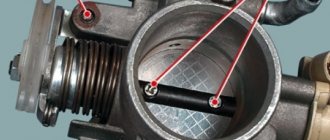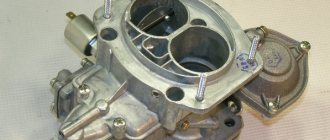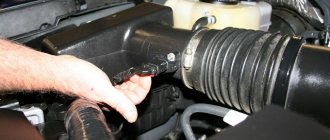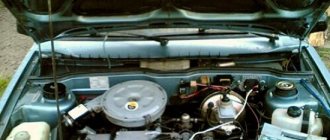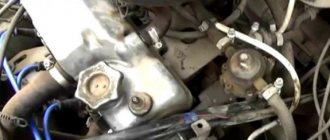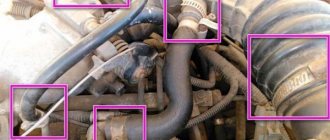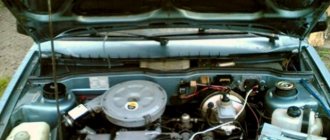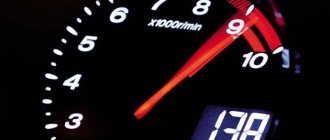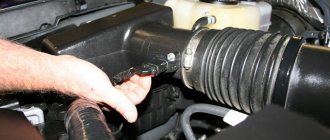If the carburetor engine of a car begins to stall when releasing gas, it means that there are problems in the operation of some carburetor systems.
Using the example of engine 21083 with a Solex carburetor 21083-1107010 of a VAZ 21093 (21083, 21099), let’s see what these systems are and what other malfunctions lead to the engine stopping in a situation where the driver, while driving a car at a certain speed, suddenly releases the gas pedal. For example, I decided to change gear or just coast along a flat road or downhill.
Carburetor engine stalls when releasing gas, reasons
When the speed drops to 1900 rpm, the EPHH resumes the flow of fuel through the carburetor CXX to prevent the engine from stalling.
If the EPHH does not work, the engine will stall when the gas is released, since in one case the fuel supply in the IHH mode will not be turned off and the spark plugs will flood, and in the other, the fuel supply through the IHH will not resume when the speed decreases, and there is simply nothing for it to work.
Even if the EAC system is in working order and works as expected, if the idle speed system (IAC) is faulty, the engine will still stall when the gas is released. This is because, as mentioned earlier, a decrease in speed below 1900 rpm, with the throttle valves closed, will cause the EPHH to turn off and fuel to be supplied through the ACH. And since, for example, the jets and CXX channels of the carburetor are clogged and do not allow the fuel mixture to pass through, the engine will experience fuel starvation and there will be a failure in its operation, after which it will try to stall.
Only timely pressing of the gas pedal by the driver will help save the situation, and even then not always.
If the idle system is faulty, in addition to the fact that the engine stalls when the gas is released, it also idles unstably (or does not work at all).
A clogged fuel jet CXX, a wedged needle, a faulty EMC may be the cause of failure of the Solex carburetor idle system
Excess air entering the fuel mixture prepared by the carburetor depletes it and causes engine failure. In the case when the driver releases the gas, he will lean the mixture supplied through the CXX and the engine will stall because the lean mixture burns poorly and does not provide the required amount of energy to rotate the crankshaft.
In the idle system of a Solex carburetor, air leakage is possible through the sealing ring of the electromagnetic valve (EMV) and the sealing ring on the fuel mixture quality screw. They need to be checked first of all by trying to independently eliminate the failure when releasing gas.
Rubber sealing ring on the solenoid valve (EMV) of the Solex carburetor 21083
If the clutch driven disc is worn out or damaged, torque can be transmitted from the engine crankshaft to the gearbox input shaft only by maintaining high speeds as it slips relative to the flywheel and pressure plate. When you release the gas (when the gear is engaged), the speed drops, and it becomes insufficient to ensure the transmission of torque from the flywheel through the driven disc to the clutch driven disc. The driven disk begins to slip, the driver feels jerking, and the engine tries to stall.
Checking the clutch drive of VAZ 21083 (21093, 21099) using a tape measure
The situation can be aggravated by the presence of carbon deposits on the spark plugs (black, oil, mixed, etc.) since the spark also flows through it very well.
Notes and additions
Let’s look at the causes of the problem “why the car engine stalls when you let off the gas.” Using the example of the carburetor engine 21083 of the VAZ 21093 (21083, 21099).
Forced idle mode of a carburetor engine
To quickly and accurately diagnose the causes of this malfunction, you need to know what happens when the gas is released from the car engine. When releasing the gas (during gear shifting or coasting - engine braking), the engine runs on the so-called. forced idling (FID). In this mode, no fuel enters the carburetor at all, since the throttle valves of both chambers are closed (the HDS does not work), and the idle system is closed by an electromagnetic valve. The pistons move in the cylinders only due to the rotation of the shaft and the operation of the transmission. The engine turns from a producer of energy into a consumer.
In the IRR mode, the engine can operate both briefly and for quite a long time (for example, while descending a car from a slope with the gear engaged and the gas pedal released).
Why is this necessary? This is necessary for the environment and fuel economy. Since if you do not stop the fuel supply in this mode, the conditions for its combustion, with a sharp decrease in the air supply to the cylinders, worsen. As a result, CO emissions into the atmosphere increase. Fuel consumption is increasing.
In order to control this mode, a forced idle economizer system - EPHH - was installed on the carburetor.
Operation of the EPH system of a Solex carburetor when releasing gas
The EPHH system includes a control device - an electronic control unit (black box on the engine compartment panel), two signaling devices - a screw sensor (carburetor quantity screw) and terminal “K” of the ignition coil. There is also one actuator - an electromagnetic valve (EMV), which closes the fuel nozzle of the carburetor idle system with its needle.
Based on the signal from the screw sensor (the damper is open or closed) and the pulse frequency from the ignition coil (crankshaft rotation speed), the control unit determines the onset or termination of the IAC mode. And accordingly, it stops or resumes the fuel supply through the SXX, turning on or off the EMC.
The control unit determines the onset of a critical illness based on the simultaneous fulfillment of two conditions:
— the throttle valves are closed (the unit receives “minus” from the screw sensor);
- crankshaft rotation speed above 2100 - 2300 rpm.
At the same time, the solenoid valve is de-energized, its needle closes the passage hole in the CXX fuel nozzle. Fuel does not enter the engine through the CXX, and it operates in forced idling mode, without emitting CO and without consuming gasoline.
The engine stalls when I let off the gas, why? Causes of malfunction.
The main reason that the engine stalls when releasing gas is the over-enrichment of the fuel mixture in the EPH mode, due to the fact that the needle of the EPH solenoid valve does not close the fuel nozzle of the idle system in a timely manner. When, when releasing gas, the throttle valves are closed, the amount of air passing through the carburetor is sharply reduced, and the vacuum under the valve, on the contrary, increases sharply and draws gasoline through the CXX into the intake manifold. The composition of the fuel mixture suddenly becomes too rich, and the enriched mixture does not really want to burn. The engine stalls (or tries to stall).
Why is this happening? Most often, the matter is a failure of any of the devices of the EPH system or a malfunction in its electrical circuit (for example, a “break”), after which the car engine begins to stall when the gas is released. What to do if the EPHH system fails and how to check it in the article on the website “Checking and repairing the EPHH carburetor Solex 2108, 21081, 21083”.
The following problem often occurs: your favorite VAZ stalls when you let off the gas. The VAZ is a simple car, and it won’t be difficult to figure out any problem. Yes, this also applies to other brands. You just need to know how the engine and fuel supply system work. By gradually eliminating all possible malfunctions, you can solve the problem of the car stalling while driving when you let off the gas. Where to start?
Candles
Let's start with the basics - candles. If the engine stalls when you release the gas and loses dynamics, the first reason is the spark plugs. Checking them is quite simple: unscrew them and look at the contacts. If they are sooted, then most likely there is no spark and, as a result, the cylinder is switched off from engine operation. If possible, it is better to change the kit; if not, clean the contacts and go to the nearest auto shop. When cleaning, you should try not to change the distance between the contacts. This operation is performed with simple sandpaper; if you don’t have it, then a pocket knife will do.
Unit repair
Initially, you need to try adjusting the float chamber. Process:
- Start the engine and turn it off.
- Check fuel volume.
- If the float chamber is not half full of gasoline, you need to adjust the float lever to the required value.
- Reassemble the carburetor and start the engine again. If no improvement is observed, repeat the procedure.
If this does not help, you need to start adjusting the carburetor or setting the ignition.
Checking the idle speed sensor (IAC)
Finding the sensor is not difficult; it is located under the throttle assembly and is secured with two bolts. If the throttle assembly (DU) has not been cleaned for a long time, then the conical needle of the sensor and its seat could become clogged and produce incorrect data. The main reason indicating a sensor malfunction is that the car stalls when releasing the gas and changing gears. The problem is solved by removing the throttle assembly and washing it with carburetor cleaner. It is difficult to remove the sensor itself without a remote control. All you need is a small screwdriver and a lot of flexibility. There is also a high chance of missing a screw or two. Usually no one has a replacement for them.
Poor quality gasoline is harmful
Many problems when operating the propulsion system of a VAZ car are associated with the use of low-quality gasoline. Leftover gasoline at unreliable gas stations is very dangerous. The entire fuel line, carburetor, and possibly even the engine may need to be flushed. It is quite possible that the units will have to be disassembled, washed, soaked and blown with compressed air.
If circumstances force you to refuel in an unfamiliar place, use caution.
| What to worry about | What results will this give? |
| Try not to use fuel filled in a proven location until the tank is empty. | Let there be at least a mixture of good and risky fuel in the gas tank, and not just questionable fuel - this will reduce the risk. |
| Fill only the minimum amount of fuel. | One that will allow you to get to a proven gas station worthy of your trust. |
| On long trips, carry a cleaning additive with you to add to your gas tank. | It is likely that you will be able to get away with adding the appropriate additive to the fuel tank when using questionable gasoline. It's like getting a flu shot - it boosts your immunity. |
Injectors
Fuel is injected into the cylinders through electromagnetic injectors. Due to poor quality fuel, they can become clogged and not allow enough fuel into the cylinder. Hence we have the fact that the car stalls when the gas is released. The injectors are installed on the fuel rail. Everything can be easily removed, and you can carry out the injector cleaning procedure yourself in your garage. You just need to first buy new rubber gaskets for the injectors and carburetor flushing fluid. We put the wires from the battery on the nozzle and supply liquid from a can of cleaner into it under pressure through a standard tube. It is necessary to achieve good atomization of the liquid coming out through the nozzle; when voltage is applied from the battery, the nozzle should click. If this does not happen, then it must be replaced. But it’s better to contact a service center that has the necessary equipment and will do the washing procedure much better.
How to clean a VAZ-21099 carburetor
If a thorough inspection shows that all parts are intact and undamaged, it’s time to start cleaning the carburetor. Do it like this:
- Turn on the car engine and warm it up to a temperature of 90 degrees.
- Record the values displayed on the tachometer.
- Armed with a screwdriver, begin the adjustment process. Turn screw 1 clockwise until it stops. When the engine stalls, turn it back a couple of revolutions and start the power plant. If startup does not happen, make another turn counterclockwise.
- Unscrew the fasteners until the increase in rotation of the crankshaft stops. Next, unscrew the screw one more circle. To control the speed, rely on the tachometer readings from the outside. If the values do not change, return the screw to the position where the increase in rotation stopped - one turn of the screw.
- The limit readings of the tachometer are 1020 beats per minute. Now turn screw 2, which controls the “quality” of the fuel. It is necessary to reduce the number of rotations to 850 beats per minute.
Fuel pressure regulator (FPR)
The RTD is quite easy to find; it is installed on the fuel rail and has the shape of a cylinder. It is a regular valve that reacts to excess pressure and supplies more fuel to the engine. Again, due to low-quality fuel, it can become clogged and jam. This malfunction is not critical, but because of it, when you release the gas, the car stalls, the engine is difficult to start, dynamics are lost, and the idle speed “floats.” RTDs are inexpensive in stores and available almost everywhere. Changes in a few minutes.
Procedure: from simple to complex
The simplest solution is to sell the car. Maybe this is the best decision. When your car has a high mileage and service life, and you are not a professional auto mechanic, then there is no point in undertaking repairs. If you are not very strapped for money, if numerous “unreasonable” breakdowns occur, perhaps the best solution is to exchange the VAZ 2109 for a simple used foreign car or a new Lada.
But if you decide to tinker with your Samara and adjust the idle speed yourself, start with simple things. Inspect the electrical wiring, inspect the contacts, touch the connector pads. The causes of floating faults often lie in the vehicle's electrical wiring. It gets hot and dry - there is contact, gets wet and cools - there is no contact.
If, when moving the wires under the hood, a malfunction appears and disappears, start ringing the wires one by one. Particularly vulnerable in the “nines” is the harness that leads to the fuse box. It is located next to the drain coming from the windshield, and during precipitation it gets wet more intensely than others.
Among other simple things that can cause the 9's engine speed to fluctuate at idle is a clogged air filter. This applies to both carburetor and injection versions of the power plant. It's easy to check.
Remove the air filter from the preheated engine, leaving the carburetor inlet pipe freely open. Start the engine. If the speed stabilizes, change the air filter. If not, install the filter back and move on to further research.
Mass air flow sensor (MAF)
The most expensive sensor, therefore, it is changed as a last resort when all else fails. It is located on the pipe, after the air filter. It's easy to check: remove the connector from it and start moving. If the engine does not stall when you release the gas, then the reason is in the sensor. It's difficult and tedious to understand. It can be treated by specialists with equipment, but it will cost about the same as the sensor itself. Therefore, it is better to buy a new one. The main thing when purchasing is to indicate the number and manufacturer that is indicated on your sensor. Your ECU firmware may not work correctly with other sensors. Installed with simple clamps. We also recommend changing the air filter along with it. It costs a penny, but it will protect you from failure of the new mass air flow sensor.
Procedure: from simple to complex
The simplest solution is to sell the car. Maybe this is the best decision. When your car has a high mileage and service life, and you are not a professional auto mechanic, then there is no point in undertaking repairs. If you are not very strapped for money, if numerous “unreasonable” breakdowns occur, perhaps the best solution is to exchange the VAZ 2109 for a simple used foreign car or a new Lada.
But if you decide to tinker with your Samara and adjust the idle speed yourself, start with simple things. Inspect the electrical wiring, inspect the contacts, touch the connector pads. The causes of floating faults often lie in the vehicle's electrical wiring. It gets hot and dry - there is contact, gets wet and cools - there is no contact.
If, when moving the wires under the hood, a malfunction appears and disappears, start ringing the wires one by one. Particularly vulnerable in the “nines” is the harness that leads to the fuse box. It is located next to the drain coming from the windshield, and during precipitation it gets wet more intensely than others.
Among other simple things that can cause the 9's engine speed to fluctuate at idle is a clogged air filter. This applies to both carburetor and injection versions of the power plant. It's easy to check.
Remove the air filter from the preheated engine, leaving the carburetor inlet pipe freely open. Start the engine. If the speed stabilizes, change the air filter. If not, install the filter back and move on to further research.
The calibration hole in the throttle assembly is clogged
Pay attention to your throttle body. A small tube goes from it to the valve cover. This is a low ventilation hose. The calibration hole in the throttle assembly is often clogged with dirt and dust by drivers who neglect to replace the air filter. The problem can be resolved by cleaning the hole with a piece of wire. To do this, you need to remove the throttle assembly to prevent dirt from getting into the engine. It can be removed simply by unscrewing two 10mm bolts and disconnecting the throttle cable.
Fuel pump is faulty
A fuel pump malfunction may be caused by oxidation of the wires in the connector. The power supply to the fuel pump is unstable, and, as a result, fuel is simply not supplied to the engine. This can be fixed by simply cleaning the contacts. There may also be a problem with the pump itself. Nothing lasts forever, and it can fail. But the most common fuel pump malfunction is contamination of the primary strainer. There is no point in washing it; it is better to buy a new one and replace it.
In this article, we looked at the most common reasons for the engine stopping while driving. If the information presented in the article does not help solve the problem, we strongly recommend that you contact a car service center.
For normal engine operation and acceptable fuel consumption, it is necessary that all power unit systems operate properly. In this case, the engine should operate normally both under load and in idle mode.
In this article we will talk about why engine speed does not drop, and also consider the main reasons why such problems arise on carburetor and injection cars.
What causes it to stall?
If you have a carburetor nine and it does not want to start, the following vehicle malfunctions may be the cause:
- the battery has either already served its purpose or has lost its charge - in this case, the starter can turn, but due to the lack of energy, the ignition is blocked. In case of this breakdown, it will be enough to charge the battery or replace it;
- if the synchronizer sensor is connected incorrectly (the poles of the wires are reversed), you just need to change them from one place to another, checking them before doing so;
- if the valve on the gearbox is depressurized, in this case the car will be in trouble, because gasoline (or its vapors) will enter the receiver and enrich the combustible mixture. To eliminate the malfunction, you need to restore the tightness of the gearbox valve.
A very common problem that drivers of nines encounter is when the car stalls immediately after starting. Sometimes the machine starts working on the third or fourth try, but then starts to misbehave again. You should not ignore such moments. It’s better to take a look and fix the problem right away. In this case, it is better for inexperienced mechanics to go to a service station. Cleaning the throttle valve, adjusting the idle speed or replacing the IAC may help if:
- the car stalls immediately after starting (whether the engine is cold or hot);
- idle speed returns to normal after heavy gas release;
- You can start the car only by using the accelerator;
- When braking hard, the motor turns off.
In order to find the problem, you need to diagnose your car. This procedure will help you determine for sure where and what needs to be repaired.
When releasing the gas, the speed is increased or “freezes”: common malfunctions
Let's start with the fact that on many cars with an injector, the ECU raises the speed while the internal combustion engine is warming up. This is necessary to ensure that the power unit operates stably after a cold start.
However, after the temperature rises, the control unit reduces the idle speed, bringing it to normal. On many cars with a carburetor, the driver independently increases the speed during warm-up, using the so-called “choke”.
Moreover, after the engine is warmed up, the normal idle speed is, on average, 650-950 rpm. If you press the gas and release the accelerator, the speed should increase, and then decrease again to the specified values.
- So, let's start with common carburetor problems. Often the engine speed does not drop due to problems with the throttle valve. For example, when the driver steps on the gas, the throttle must be opened wider to allow more air to enter the cylinders to burn fuel. After the gas pedal is released, the throttle closes and the speed decreases.
If the damper does not close completely, an over-enriched mixture enters the cylinders, and the speed is increased. The cause may be severe contamination of the throttle assembly or damage to the valve itself (deformation). First you need to clean the damper; carburetor cleaning liquid is suitable as a cleaner.
We also recommend reading the article about why the idle speed is increased. From this article you will learn about the reasons for high idle speed on an injection or carburetor engine, as well as methods for diagnosing and repairing this problem.
We also note that the damper does not close tightly even when the drive cable is worn out. In this case, the cable must be replaced. On carburetor cars, engine speed often does not drop even if the gasket between the carburetor and the cylinder head has failed. The culprit may also be an intake manifold that is damaged.
The main task is to find the correct ratio of fuel and air. Often, a high level of fuel in the carburetor float chamber also leads to increased speed. The check should begin with the needle valve.
- Now let's move on to the injector. Please note that on many injection cars, after cleaning the throttle valve, the assembly also needs to be additionally “trained”. As for problems, the injection system itself is more complex, that is, there are more reasons for high speeds compared to the carburetor.
In simple words, if the specified sensor gives an incorrect signal, the ECU considers that the engine is cold and activates the warm-up mode. In this case, the control unit raises the speed so that the power unit operates stably and reaches operating temperature faster.
Special attention should be paid to gaskets, since air leaks can lead to disruption of mixture formation. This means that you need to separately inspect manifold gaskets, injector seals, etc.
Car chip tuning
Chip tuning - this word refers to the simple adjustment of the injector and electronic engine control system in order to improve its performance.
Firmware can prepare the car for the quality of local fuel, certain operating temperature conditions, and also determine exactly how much fuel the engine will consume in normal modes.
Advantages of chip tuning
Among the main advantages that a car receives after such modifications are:
- accelerated start from a place,
- smooth movement with minimal load,
- as well as the most even traction that occurs when working in the highest gears.
And, of course, if you are pursuing the goal of saving, you can significantly reduce fuel consumption. Depending on the car model and previous settings, consumption can be reduced by half a liter to three liters per hundred kilometers.
You can’t do without a special diagnostic program
However, it is recommended to carry out all settings only at a service center. As a rule, specialists from such service stations work only with proprietary software, and also install only those firmwares that have already been tested in real conditions. If the firmware is not of sufficient quality, then you will have to pay for the car’s sporting achievements.
This is what a set of diagnostic equipment looks like
Many motorists have experienced the effect of a drop in idle speed on their car. Often, this leads to the engine stalling altogether. This effect has many causes that need to be addressed urgently so as not to cause even bigger problems.
Floating speed: reasons
Note that in some cases the revolutions do not just slowly fall or remain at the same level, but “float”. In this case, the engine may become unstable. Floating speeds first fall, then increase sharply and everything repeats. A common cause of this phenomenon is the supply of excess air, which leads to “jumps” in speed at idle.
If malfunctions occur, the control unit cannot prepare the “correct” mixture for the idle mode, which causes speed jumps after releasing the gas pedal or when the engine is idling.
Check and adjustment
If all components are in good working order, the readings of the device should be the same in accordance with the operating instructions for the VAZ 21099 car. If the readings vary widely, remove the head and check it for the integrity of the valves. If necessary, we replace the valve. If the problem is not in the valves, you will have to disassemble the engine.
Next, you should adjust all the devices. We start the car and check. The tachometer needle should stop jumping and the engine will start running normally.
To avoid this kind of problem, it is important to promptly clean and replace filters, spark plugs, and check the wiring. It is advisable to change the sensors (injector) at the slightest malfunction. There is no need to delay repairs, because floating speed will sooner or later lead to breakdown or rapid wear of the engine.
Let's sum it up
As you can see, in order to accurately determine why the engine speed is not reset, in many cases in-depth diagnostics may be necessary. For carburetor engines, cleaning and adjustment of the carburetor itself is often necessary, while the injector will require computer diagnostics.
We also recommend reading the article about why engine speeds fluctuate at idle. From this article you will learn about what could be the reason for jumps in the speed of a cold or hot engine when idling.
If the problem is not on the surface (the throttle cable has become sour, after washing or dry cleaning, the carpet in the cabin is not installed correctly, which presses the gas pedal, etc.), then it is better to take the car to a service center.
The most complex situation is when the design of the power system involves the presence of a large number of sensors and actuators. In this case, even the use of diagnostic equipment does not always allow you to quickly and accurately determine the problem.
Finally, we note that timely detection of a problem allows you to save the life of the internal combustion engine and other components and assemblies. In other words, high idle speeds, floating speeds and jumps indicate that there are problems with the air/fuel supply or with mixture formation. Ignoring such problems negatively affects the engine and its service life.
Why the engine may have high idle speed. The main reasons for high idle speed on an injection engine and engines with a carburetor.
The engine twitches at idle: why does this happen? Engine jerking in idle mode, diagnostics of possible malfunctions, recommendations.
Why does the engine idle unevenly? There are jumps in idle speed. The main causes of unstable idling, diagnostics.
What symptoms indicate that the engine has started to stall: the main signs of engine stalling. Common causes of internal combustion engine tripping, diagnosis, repair.
At idle the speed “floats”: why does this happen? The main malfunctions associated with idle speed on gasoline and diesel engines.
Floating engine idle speed when cold. Basic malfunctions, symptoms and identification of breakdowns. Unstable idling of the diesel engine.
Hello to all owners of the VAZ 2109 car. Today we will look at the main reasons why the nine stalls. If you don’t know, the VAZ 2109 was produced from 1988 to 2006; the legendary car was produced with carburetor and later with injection engines. But they have one thing in common: they can stall in two cases, either there is not enough fuel coming in or there is a problem with a spark, or rather, its absence. Now more details.
Experienced owners of a VAZ 2109 car, if the engine does not start, first of all look for the cause of the malfunction in the spark plugs, to do this you need to unscrew the spark plug and check the spark; if there is none and the spark plug is in good condition, then you need to go to the distributor. You need to remove the distributor cover and check the contacts, they may be burnt. You also need to carefully examine the carbon rod, which is located in the center. It may be worn out or stuck and not reaching the slider plate. It is also not uncommon for cases when a crack appears on the distributor cap, resulting in a short to ground.
If you are convinced of the integrity of the contacts, then you can install a new slider and check the spark. If this does not help, then you need to check the ignition coil and switch; this is done by replacing it with new ones. In rare cases, the cause of an ignition failure may be poor contact in the switch block. If all actions were in vain and the VAZ 2109 continues to stall, then you need to check the hall sensor, which is located in the distributor. You also need to check the ignition switch; the contacts could have burned out.
If a VAZ 2109 has a carburetor and a spark is present, then the most likely cause of engine failure will be clogging of the jets located in the carburetor. Usually they are purged with air; to get to the jets you will need to remove the filter and carburetor cover along with the floats. You also need to pay attention to the fuel level in the float chamber. You can blow it out with a tire pump; at the same time, it is recommended to clean the bottom of the float chamber from dirt.
If the engine of a VAZ 2109 car stalls at idle, then the solenoid valve is to blame, which will have to be replaced with a new one. Another reason may be an insufficient amount of fuel entering the cylinders. Most likely, this is due to the solenoid valve not being tightly screwed in and air leaking, thereby depleting the combustible mixture. The next reason is the sticking of the needle valve of the float chamber. As a result, the fuel level drops and the mixture again becomes lean.
On an injection VAZ 2109 with a working ignition system, it is quite difficult to find the cause of the failure of this system, but there is a “Check engine” button on the instrument panel and if this indicator lights up, you need to go for diagnostics in order to deal with the errors that the injection system controller produces. Well, that's all, we've looked at the main reasons why the VAZ 2109 car stalls. Bye everyone.
The VAZ 2109 car is equipped with two types of engine power systems - an injector and a carburetor. As you know, the carburetor system, due to its heavy design, is more often susceptible to any malfunctions that affect the driving and technical performance of the car. Therefore, in this article we will consider the carburetor type of power supply.
Let's list them.
- The most basic is a malfunction or failure of the mass air flow sensor.
- No less common is the breakdown of the idle air control valve.
- A crankshaft position sensor providing incorrect information to the control unit can also be the root cause of a high or floating idle.
- The throttle position sensor may also be to blame.
- It happens that for some reason the gas pedal does not return all the way back. Moreover, this happens both because of a banal malfunction of the cable, and because of something completely ridiculous - for example, after washing the car, they covered the driver’s mat in such a way that the tip of the mat began to touch the pedal.
- The air filter is very clogged. Because of this, the combustion mixture is too rich in gasoline, again resulting in high idle speeds.
- The cable came off the throttle valve.
- Engine temperature sensor faulty. It gives the car’s “brains” incorrect values, which increase the crankshaft speed, thinking that the engine is cold.
As you can see, we have before us a whole forest of very different reasons why high revs appear! Next, we will take a closer look at the most typical, plus the most common problems associated with the problem described. At the same time, we’ll figure out how to eliminate them with our own hands.
Ways to eliminate the “sore”
If such a problem occurs, you need to look for which node is to blame analytically, checking all the specified sensors
First, let's consider the following option for correcting the problem situation. Let's assume that a VAZ 2110 has high revs. An examination of the suspected components for faulty components showed that the throttle position sensor has traces of rust. It is located directly above the throttle valve. Measurements with a voltmeter showed that when the engine is idling, the voltage on it remains high - which means it does not close the damper.
How to fix the problem? For this we only need a screwdriver. Let's begin the procedure.
- By disconnecting the terminal block and also unscrewing two screws, we dismantle the assembly. We notice that traces of rust inside interfere with the movement of the wheel that regulates the position of the damper.
- We fill the insides of the defective device with a penetrating anti-rust aerosol.
- Use a development screwdriver to turn the wheel.
- We reassemble in reverse order.
Check to see if the engine idle speed is now high. The problem should go away.
Now let's look at another case. Let's say we have high idle speed in a VAZ 2114. This is what we do when faced with this situation.
When clarifying the circumstances of the problem under investigation, we always initially check the operation of the idle speed sensor. This device consists of a needle built inside an electromagnetic coil. The needle either moves inside the coil, moving away from the hole in the throttle pipe, or moves out, closing this hole, thereby stopping the supply of air for combustion of the mixture.
This element is located at the throttle valve, opposite the gas pedal cable. To diagnose it, we pull out the terminal block from it, start the car, after which we see that we still have high engine speeds that have not changed at idle. Then we remove this defective unit, then clean it or replace it. For work we take:
Causes of the problem
Quite often, VAZ 2109 owners are faced with a problem when the carburetor does not hold speed while idling, and the engine simply stalls. There can be many reasons, and they are all united by a number of characteristic features.
The first reason is a clogged idle jet. Even though the fuel supply system has 2 filters (coarse and fine), even one speck may be enough to clog the nozzle.
Also, the fine filter itself may become clogged. This often happens when the filter was not replaced with a new one in time. Less commonly, malfunctions in the idle system occur.
There is no difference at all between the symptoms for any of the causes of the problem. Determining what exactly needs to be cleaned or changed can only be done through a visual inspection or diagnostics.
Also, sometimes the revs not only disappear completely, but also float. At the same time, the VAZ 2109 car does not stall. In this case, to the above reasons, you should add: a faulty solenoid valve or idle speed sensor.
A little history
Despite the fact that the model seems old, its release was planned in March 1990, but happened a little later. In December 1990, the VAZ-21099 began to be produced in large series. The Ukrainian plant assembled this car until 2011 from Russian special vehicle kits.
The version from Ukraine had a slightly different name - ZAZ-21099. VAZ-21099 was produced under various names. They all differed in interior, details, year of production and country of assembly. Export names of VAZ-21099:
- Saloon
- Lada Samara
- Lada Sable
- Lada Sagona
- Lada Forma
- Lada Victory
All these cars had the common name “Samara”. But the VAZ-21099 had significant differences from everyone else.
- The front part of the body had long wings.
- Longer hood.
- No plastic “beak” at the front.
- New radiator grille.
- The instrument panel is gray (in other models the dominant color is brown).
This is how people of that time remember this car. But in 2004, the VAZ-21099 was completely discontinued at AvtoVAZ and replaced. Instead of the old, well-known model, the VAZ-2115 appeared. This is what made Ukrainian collectors continue to collect the legend. However, in 2011 this car was discontinued in all countries.
Together with it, they stopped producing the VAZ-21093. VAZ-21099 Victory is considered the most advanced model. Its most important advantage is that it had standard machine parameters (4x4). However, it has only a few improvements from the old model. Added.
- Rear axle gearbox from Volkswagen Golf Syncro.
- Viscous coupling.
- Angular gearbox.
- Transmission.
Victory is also distinguished by incredible dynamics, since the engine is forced. Its cross-country ability met all standards, which was perfectly possible with all-wheel drive. But times have passed, and the model has not received wide recognition. Therefore, the enterprise soon ceased its work.
Many people today prefer this car for two simple reasons.
- In terms of price, it is much cheaper than modern foreign cars, easy to maintain, and has inexpensive spare parts.
- Patriotism and the desire to preserve the legend.
But despite the fact that the reasons are compelling, and the car is of really good quality, times have taken their toll, and therefore, no matter how much one would like to admit it, the car is capable of breakdown. The carburetor is the first to suffer.
Troubleshooting
The idle jet located in the float chamber must be removed and checked for debris or debris. If debris is found in the nozzle hole, it must be blown out and washed with gasoline. If there is no debris in the hole, then we continue to look for the cause further.
We have examined the carburetor, now we can move on to the fine filter. Look at the condition of the gasoline in the filter sump. If there is no sediment at the bottom, the filter is still in good condition. If there are at least some particles at the bottom, it needs to be urgently replaced.
Old and new filter
After you have cleaned the carburetor and changed the fine filter, start the VAZ 2109 and check its operation at idle. If the speed still fluctuates or the engine stalls, the idle speed sensor may be the cause.
You can check the sensor in the following way: disconnect the wires from it and check it with a voltmeter. We put the negative wire to ground, and the positive wire to the block connector. Turn on the ignition and monitor the instrument readings. The sensor should produce a voltage of 12 volts. If there is no such current, then the sensor is most likely faulty.
If, after the procedure, it turns out that the sensor is in normal condition, but there are still no changes (the speed floats and the engine stalls), then the last option remains - the solenoid valve. It is quite difficult to check it, therefore, it is easier to install a new one.
Now, your VAZ 2109 car should work stably, both at idle and while driving. If the engine still stalls, although the speed no longer fluctuates, then the reason is much more serious, and most likely, special diagnostics and specialist intervention will be required.
Sometimes such a nuisance happens on the way, the driver finds himself in a situation where the engine of a VAZ 2109 stalls in the middle of the road and it is impossible to start the car further. The most interesting thing in such a situation is that there were no traces of any signs warning (foreshadowing) these problems, the car drove as usual, there was no “sneezing” or “shooting in the muffler.” Since the problem is common, our instructions will tell you what to do in a situation such as a sudden stop of the engine and poor starting. We will consider in detail all the main reasons that cause the engine to stop at idle and while driving. And also the reasons why it does not start when warm and how to solve this kind of problem.
FakeHeader
Webster568 +100500? The same garbage was only on Kalina, diagnostics showed that everything was normal, but there was a glitch, I changed the idle sensor, it didn’t help, I replaced the DPD at first it didn’t help, but the situation went away, I bought another one from a different manufacturer, and everything went away. replacement was for 80 thousand. Now 124 flight is normal
I had exactly the same problem on 2113, I changed the TPS... although before that there was a sensor that was 2 months old... in general, I changed it, the speed doesn’t float, if you find a problem, please write back, it’s very interesting
suction, masses most often
I should have written without commas))
it somehow turned out ridiculous)))) suction and masses))))
similar to VUT, when you press the brake it gets worse?
Hmm, are all the sensors normal? I do not believe. What other symptoms?
Most likely it’s a vacuum leak; I had a similar problem on an 8-valve engine. If the vacuum chamber is not working properly, then excess air will be taken from it. And this results in floating revolutions.
Air leaks, there was a situation like this, we replaced all the sensors, but everything turned out to be much simpler
I had this problem with everything not long ago, I installed a new TPS and the problem went away.
control unit weight
looks like the masses
Also check the process plugged at the bottom of the throttle, which is supposed to go to the adsorber, sometimes this plug is full of cracks.
A friend had something similar... I installed a new air filter and put a new corrugation on the standard air intake and everything went away...))) I laughed for a long time)))
put soapy water in a spray bottle and spray the corrugation, the receiver in the places where it is screwed on, the injectors, if it’s a leak, you can find it, I had a similar thing, but it turned out to be a month old, the speed took longer for me to recover.
1. Look for air leaks at the intake. 2. If you are changing sensors or actuators, take known good ones from a known good working engine, because spare parts are now a lottery. And rewiring the brain does not always solve the problem.
Try with the DMRV, drop the chip and go for a ride. This was due to the air flow sensor, although the voltage showed 1.00. Then I went and bought a new one and I don’t know what’s wrong
A neighbor had the same problem with a 99... all the sensors were changed, the air flow sensor was installed from a working car, the injectors were washed, the damper, all to no avail. The services also shrugged their shoulders, and then we went to Kulibin... I examined everything for half an hour, and then I changed the rubber bands under the injectors and the idle levels leveled out... I said they had dried out and were sucking air.
It may not hiss, but there will be a suction)…I’m still sinning more with the mixture, so I’ll flash it with adact firmware, they say it’s a high-quality firmware)
)))) the situation is this: you need to slightly tighten the throttle position screw; it is located on the opposite side of the IAC
I understand what you mean)
)))) the situation is this: you need to slightly tighten the throttle position screw; it is located on the opposite side of the IAC
why go there? If it's not twisted from the factory, then you shouldn't twist it.
Same thing, manifold without leaks, all sensors are normal, MAF is new, compression is 12, the ignition module is quite normal, the air intake is clean, the valves are adjusted, the mesh in the tank is new and the fuel and air filters are clean, the pressure is normal, the oil is changed everywhere But, But it probably doesn’t affect it, it doesn’t eat it... the injectors are clean... I have a couple of guesses. 1) this happened on the carburetor, I adjusted the mixture quality and everything returned to normal 2) air leaks into the inlet
Engine stalls at idle
On a VAZ 2109 the engine stalls at idle for the following reasons:
- The most common of them is the idle speed sensor (regulator), on which the idle speed of the engine directly depends
Idle speed sensor (regulator)
- Checking it is quite simple. When the car does not start due to rotation of the starter, then also work with the gas pedal, the engine should start
- In the case when the speed immediately begins to fluctuate, after removing your foot from the gas pedal, 99% out of a hundred, that the reason lies precisely in the regulator, so the price of the issue here is ridiculous
- The solution is simple - replacing the regulator, this takes any VAZ owner a minimum amount of time
- The second most likely reason why the VAZ 2109 engine stalls when idling is a problem with opening the throttle valve
- The cure for such a “disease” is trivial - clean the throttle valve
- When cleaning the throttle valve does not solve the problem, suspicion falls on a malfunction of the throttle position sensor; when it is faulty, the engine will also stall at idle.
- We solve the problem by replacing the TPS, this procedure is not difficult and can be easily done with your own hands
XX speed floats on VAZ injector
There are various reasons for this, such as improper operation of the controller and operation of the injectors. To know exactly the nature of the malfunction, the easiest way is to conduct electronic diagnostics of all systems and determine the cause of the malfunction using the error code. This list may include the following items.
- The injector is very dirty or leaking . Injector contamination occurs when low-quality fuel is used or the engine is driven to fuel starvation, when the gasoline pump pumps not gasoline, but its residues at the bottom of the fuel tank. In this case, special additives are used that clean the part during engine operation.
If the injectors are leaking, they must be replaced. This is due to the deterioration of the quality of the sealing gaskets installed inside the element, which violates the tightness of the system and allows excessive amounts of fuel to enter the combustion chamber.
Attention! Leaking injectors can overfill the fuel chamber and cause increased pressure in the cylinder (water hammer). This phenomenon can negatively affect the internal parts of the engine.
Another problem may affect the idle speed sensor (regulator), which fails and gives the wrong command to the crankshaft speed. As a result, the engine runs intermittently and may even stall. By the way, the idle speed sensor is not the only electrical device that affects the stability of the engine. Among others, we can note the mass air flow sensor and many other devices, information from which is no longer sent to the ECU. The controller, without the necessary information, can put the engine into emergency mode (Check Engine).
